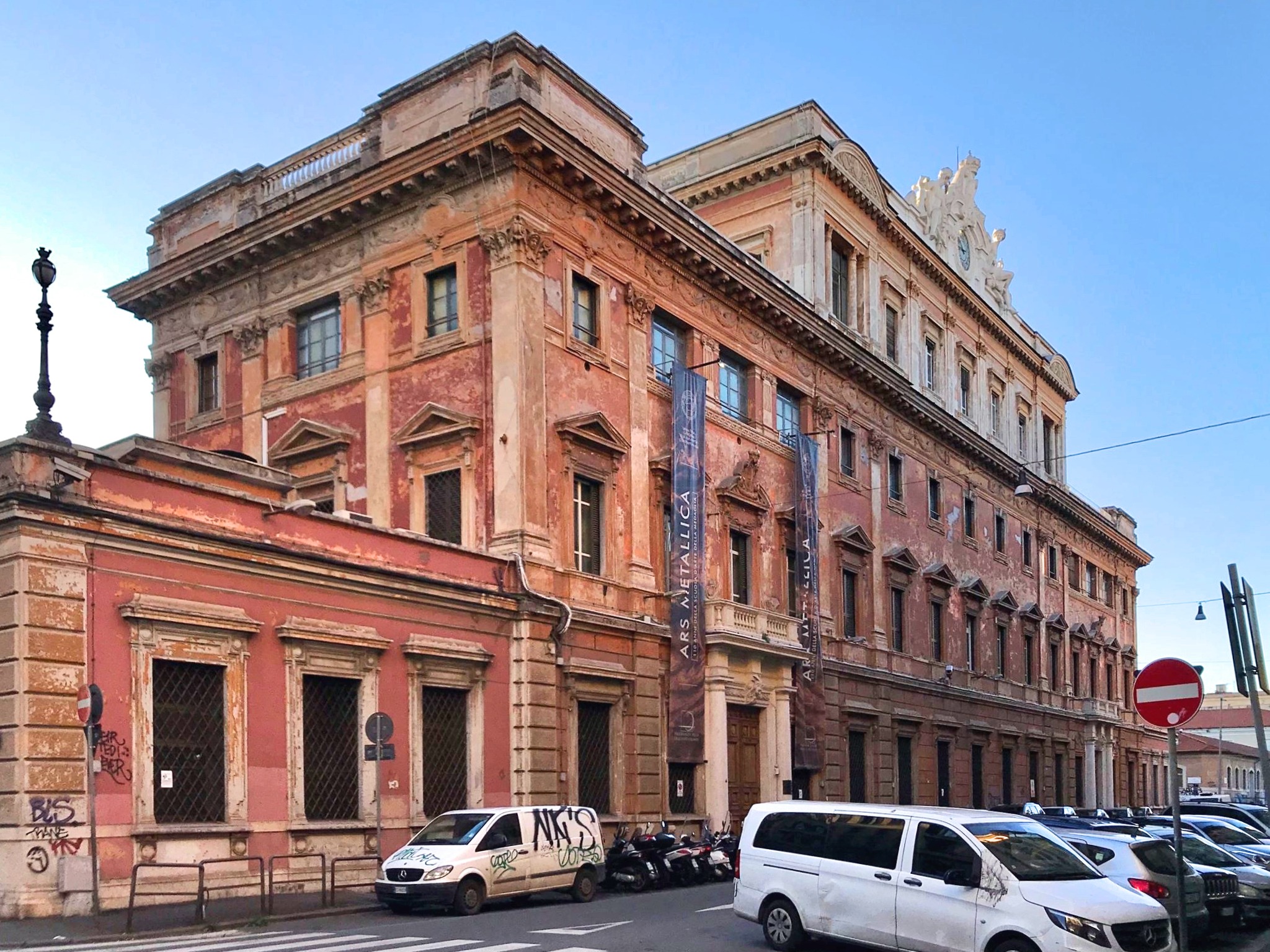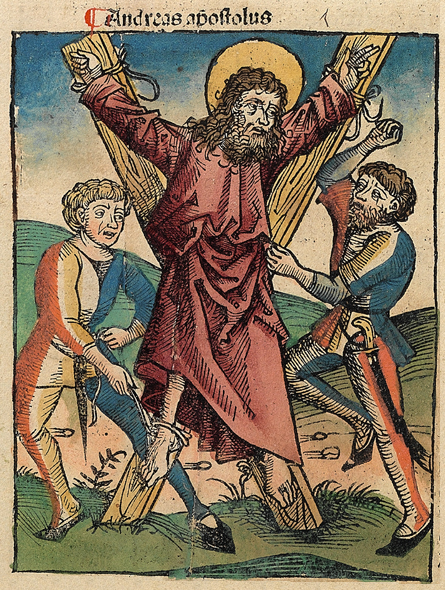|
Sant'Andrea Catabarbara
Sant'Andrea Catabarbara was a church in Rome, located on what is now the site of the Pontifical Oriental Institute on Via Napoleone III, in the Esquilino district. It was first called ''Catabarbara'' or ''Cata Barbara Patricia'' in the eighth century. It was the first devotional church dedicated to Saint Andrew in the city of Rome. Its foundation probably dates to the donation of an ''aula'' or hall from the home of Junius Annius Bassus, consul in the year 331, by the Goth general Valila. An inscription from the apse of the church possibly records the donation, though its meaning is uncertain. The church was therefore the result of the transformation from a secular home or house-church into a church, due to the work of Pope Simplicius in the second half of the fifth century. The hall was turned into a monastery to serve the nearby Basilica of Santa Maria Maggiore. It and its rich decoration were demolished to build the Pontifical Oriental Institute in 1930. Bibliography * Maria ... [...More Info...] [...Related Items...] OR: [Wikipedia] [Google] [Baidu] |
Rome
, established_title = Founded , established_date = 753 BC , founder = King Romulus ( legendary) , image_map = Map of comune of Rome (metropolitan city of Capital Rome, region Lazio, Italy).svg , map_caption = The territory of the ''comune'' (''Roma Capitale'', in red) inside the Metropolitan City of Rome (''Città Metropolitana di Roma'', in yellow). The white spot in the centre is Vatican City. , pushpin_map = Italy#Europe , pushpin_map_caption = Location within Italy##Location within Europe , pushpin_relief = yes , coordinates = , coor_pinpoint = , subdivision_type = Country , subdivision_name = Italy , subdivision_type2 = Regions of Italy, Region , subdivision_name2 = Lazio , subdivision_type3 = Metropolitan cities of Italy, Metropolitan city , subdivision_name3 = Metropolitan City of Rome Capital, Rome Capital , government_footnotes= , government_type = Mayor–council gover ... [...More Info...] [...Related Items...] OR: [Wikipedia] [Google] [Baidu] |
Pontifical Oriental Institute
The Pontifical Oriental Institute, also known as the Orientale, is a Catholic institution of higher education located in Rome and focusing on Eastern Christianity. The plan of creating a school of higher learning for Eastern Christianity had been on the agenda of the Catholic Church since at least Pope Leo XIII, but it was only realized in 1917 by Pope Benedict XV. The Orientale forms part of the consortium of the Pontifical Gregorian University (founded in 1551) and the Pontifical Biblical Institute (founded in 1909), both in Rome. All three institutions are run by the Society of Jesus (Jesuits). While the Orientale depends on the Holy See, its management is entrusted to the Society of Jesus. Its chancellor is the Prefect of the Congregation for the Eastern Churches and its vice-chancellor is the superior general of the Society of Jesus, while the Congregation for Catholic Education is the dicastery competent for approving the academic programmes of the Orientale. Each year, an ... [...More Info...] [...Related Items...] OR: [Wikipedia] [Google] [Baidu] |
Esquilino (rione Of Rome)
Esquilino is the 15th ''rione'' of Rome, identified by the initials R. XV, and is Located within the Municipio I. It is named after the Esquiline Hill, one of the Seven Hills of Rome. Its coat of arms bears two figures: a tree and three green mountains, all on a silver background. It is a very cosmopolitan neighbourhood, with large numbers of immigrants from Asia and North Africa. History Esquilino is part of the historic center of Rome, where urbanization developed in ancient times. Along with ''Palatina'', ''Collina'' and ''Suburana'', the area was one of the four ''regiones'' established by Servius Tullius: until Emperor Augustus adopted a new administrative subdivision of the city, the region included the whole area that is part of the modern ''rione'' Monti. The territory of the modern ''rione'' Esquilino, however, has always been regarded as the frontier of the inner city. Initially at the edge of the Servian Wall, whose ''agger'' was located in the area, during the ... [...More Info...] [...Related Items...] OR: [Wikipedia] [Google] [Baidu] |
Saint Andrew
Andrew the Apostle ( grc-koi, Ἀνδρέᾱς, Andréās ; la, Andrēās ; , syc, ܐܰܢܕ݁ܪܶܐܘܳܣ, ʾAnd’reʾwās), also called Saint Andrew, was an apostle of Jesus according to the New Testament. He is the brother of Simon Peter and is a son of Jonah. He is referred to in the Orthodox tradition as the First-Called ( grc-koi, Πρωτόκλητος, Prōtoklētos, label=none). According to Orthodox tradition, the apostolic successor to Andrew is the Patriarch of Constantinople. Life The name "Andrew" (meaning ''manly, brave'', from grc-gre, ἀνδρεία, andreía, manhood, valour), like other Greek names, appears to have been common among the Jews and other Hellenized people since the second or third century B.C. MacRory, Joseph. "St. Andrew." The Catholic Encyclopedia Vol. 1. N ... [...More Info...] [...Related Items...] OR: [Wikipedia] [Google] [Baidu] |
Junius Annius Bassus
Junius Bassus was a praetorian prefect of the Roman Empire from 318 to 331, during which time he also held the consulate. Several laws in the ''Codex Theodosianus'' are addressed to him. His son Junius Bassus Theotecnius was ''praefectus urbi'', and his sarcophagus from 359 is one of the most decorative late antique sarcophagi adorned with two registers of Christian scenes. He built the basilica of Junius Bassus on the Esquiline Hill in Rome, famous for its ''opus sectile ''Opus sectile'' is a form of pietra dura popularized in the ancient and medieval Roman world where materials were cut and inlaid into walls and floors to make a picture or pattern. Common materials were marble, mother of pearl, and glass. The ...'' decoration. Bibliography * Elsner, J.R., ''Imperial Rome and Christian Triumph: The Art of the Roman Empire AD 100-450'', Oxford University Press, 1998, , p. 192. * Martindale, John Robert, and Arnold Hugh Martin Jones, ''The Prosopography of the Later ... [...More Info...] [...Related Items...] OR: [Wikipedia] [Google] [Baidu] |
Goths
The Goths ( got, 𐌲𐌿𐍄𐌸𐌹𐌿𐌳𐌰, translit=''Gutþiuda''; la, Gothi, grc-gre, Γότθοι, Gótthoi) were a Germanic people who played a major role in the fall of the Western Roman Empire and the emergence of medieval Europe. In his book '' Getica'' (c. 551), the historian Jordanes writes that the Goths originated in southern Scandinavia, but the accuracy of this account is unclear. A people called the '' Gutones''possibly early Gothsare documented living near the lower Vistula River in the 1st century, where they are associated with the archaeological Wielbark culture. From the 2nd century, the Wielbark culture expanded southwards towards the Black Sea in what has been associated with Gothic migration, and by the late 3rd century it contributed to the formation of the Chernyakhov culture. By the 4th century at the latest, several Gothic groups were distinguishable, among whom the Thervingi and Greuthungi were the most powerful. During this time, W ... [...More Info...] [...Related Items...] OR: [Wikipedia] [Google] [Baidu] |
Flavius Valila Theodosius
Flavius Valila Theodosius or Theodobius (died before 483) was a Roman senator and military commander who held the office of ''magister militum'' in the west in 471. Valila, who was of Gothic origin, endowed a Christian church on his property near Tibur. At his death, he bequeathed the 4th century basilica of Junius Annius Bassus (consul of 331) on the Esquiline Hill in Rome to the Church, and Pope Simplicius dedicated it to St. Andrew, which later came to be known as Sant'Andrea Catabarbara Sant'Andrea Catabarbara was a church in Rome, located on what is now the site of the Pontifical Oriental Institute on Via Napoleone III, in the Esquilino district. It was first called ''Catabarbara'' or ''Cata Barbara Patricia'' in the eighth cent ....Lizzi Testa. Notes References *Christie, Neil, ''From Constantine to Charlemagne: an archaeology of Italy, AD 300-800'', Ashgate Publishing, 2006, , p. 302. *Lee, A.D., ''Pagans and Christians in Late Antiquity'', Routledge, , p. 232. ... [...More Info...] [...Related Items...] OR: [Wikipedia] [Google] [Baidu] |
Pope Simplicius
Pope Simplicius (died 2 or 10 March 483) was the bishop of Rome from 468 to his death. He combated the Eutychian heresy, ended the practice of consecrating bishops only in December, and sought to offset the effects of Germanic invasions. Election Simplicius was born in Tivoli, Italy, the son of a citizen named Castinus.J. P. Kirsch, "Simplicius, Pope St." After a vacancy of 10 days following the death of Pope Hilarius, Simplicius was consecrated on 25 February 468. Pontificate Simplicius defended the decisions of the Council of Chalcedon against the Eutychian heresy. When the Eutychians rose up in Antioch and installed Petrus Mongus, Simplicius made repeated complaints for action to Basiliscus and Leo I, emperors of the Eastern Roman Empire, for the restoration of the Catholic bishop; he did the same when Petrus Fullo usurped the seat of the patriarch of Alexandria. He rehabilitated Patriarch Timotheos Solofaciolus. In 478, Simplicius held a synod in Rome, which pronounced ... [...More Info...] [...Related Items...] OR: [Wikipedia] [Google] [Baidu] |
Basilica Of Santa Maria Maggiore
The Basilica of Saint Mary Major ( it, Basilica di Santa Maria Maggiore, ; la, Basilica Sanctae Mariae Maioris), or church of Santa Maria Maggiore, is a Major papal basilica as well as one of the Seven Pilgrim Churches of Rome and the largest Catholic Marian church in Rome, Italy. The basilica enshrines the venerated image of ''Salus Populi Romani'', depicting the Blessed Virgin Mary as the health and protectress of the Roman people, which was granted a Canonical coronation by Pope Gregory XVI on 15 August 1838 accompanied by his Papal bull ''Cælestis Regina''. Pursuant to the Lateran Treaty of 1929 between the Holy See and Italy, the Basilica is within Italian territory and not the territory of the Vatican City State.Lateran Treaty of 1929, Article 15 However, the Holy See fully owns the Basilica, and Italy is legally obligated to recognize its full ownership thereof and to concede to it "the immunity granted by International Law to the headquarters of the diplomatic ag ... [...More Info...] [...Related Items...] OR: [Wikipedia] [Google] [Baidu] |
Mariano Armellini
Mariano Armellini (7 February 1852 – 24 February 1896) was an Italian archaeologist and historian. Born in Rome, he was one of the founders of the Pontifical Academy of Martyrs. He is the author of ''Gli antichi cimiteri cristiani di Roma e d'Italia'' (''The Ancient Christian Cemeteries of Rome and Italy'') and ''Le catacombe romane'' (''The Roman Catacombs''), but became famous chiefly for ''Le chiese di Roma dal secolo IV al XIX'' (''The Churches of Rome from the 4th to the 19th Centuries''), a major work in which he recorded many of the city's churches, including those no longer extant. External linksLe chiese di Roma dal secolo IV al XIX(on LacusCurtius LacusCurtius is a website specializing in ancient Rome, currently hosted on a server at the University of Chicago. It went online on August 26, 1997; in July 2021 it had "3707 webpages, 765 photos, 772 drawings & engravings, 120 plans, 139 maps." T ...) 1852 births 1896 deaths Archaeologists from Rome Pontifical Aca ... [...More Info...] [...Related Items...] OR: [Wikipedia] [Google] [Baidu] |
Destroyed Roman Catholic Churches In Rome
Destroyed may refer to: * ''Destroyed'' (Sloppy Seconds album), a 1989 album by Sloppy Seconds * ''Destroyed'' (Moby album), a 2011 album by Moby See also * Destruction (other) Destruction may refer to: Concepts * Destruktion, a term from the philosophy of Martin Heidegger * Destructive narcissism, a pathological form of narcissism * Self-destructive behaviour, a widely used phrase that ''conceptualises'' certain ki ... * Ruined (other) * {{disambiguation ... [...More Info...] [...Related Items...] OR: [Wikipedia] [Google] [Baidu] |
.jpg)



.jpg)
